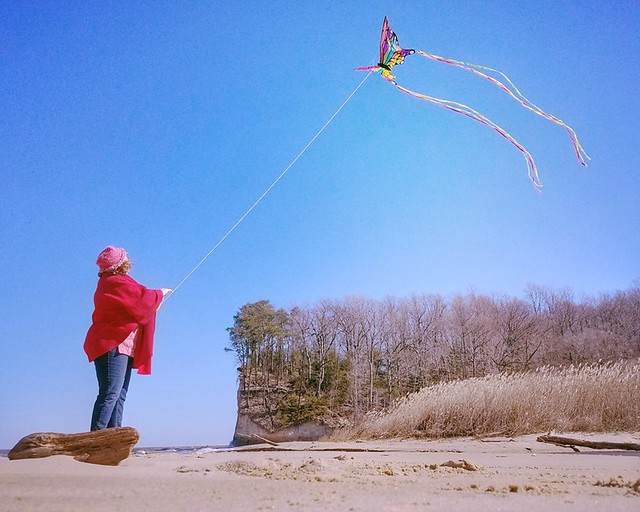Read Our Blogs
Three Great Places to Fly a Kite in Virginia
Posted February 20, 2018 | Updated February 13, 2019
Flying a kite provides a winning combination of exercise, fresh air and loads of fun, and with February being one of the windiest months in Virginia, we can't help but think it's time to dust off the kite and find that perfect place to fly.
Flying a kite along the bay at First Landing State Park in Virginia is ideal
We have some pretty awesome places to a fly kite at Virginia State Parks, since we offer plenty of open space like fields, beaches and park-like settings that are excellent for good kite take-offs, and ample running space.
And if you don't own a kite, many of our park gift shops will have some inexpensive beginner models for sale. Or, if you want to make your own kite, here's a neat site to check out, and this one.
Here are three Virginia State Parks that are especially popular for kite flyers:
Fossil Beach at Westmoreland State Park is a great place to fly a kite in Virginia
On the Potomac River's Northern Neck, this park offers many opportunities for family fun. It's listed on the National Register of Historic Places and has an Olympic-sized swimming pool and an adjacent bathhouse, meeting area, snack bar, camp store and power-boat ramp. You'll also find a visitor center, a playground, a fishing pier, boat rentals and 6 miles of trails. Fossil collectors enjoy hunting for ancient shark teeth along the Potomac. Offshore breakwaters are great for fishing.
Birding enthusiasts find the park an excellent site for spotting American bald eagles, ospreys, kingfishers, great blue herons, common terns, green herons and gulls, as well as wintering waterfowl.
Overnight: Campgrounds, camping cabins, cabins and Potomac River Retreat (lodge). Learn more here, or call 800-933-7275 to inquire.
Park size: 1,321 acres
Drive Time: Northern Virginia and Washington D. C., two hours; Richmond, one and a half hours; Tidewater/Norfolk/Virginia Beach, two and a half hours; Roanoke, five and a half hours.
See more information about Westmoreland State Park here, and directions via a Google map here.
February offers the added benefit of the parks being less crowded
2. | STAUNTON RIVER STATE PARK
Staunton River has a large open field near the swimming complex that's perfect for kite flying
Tucked neatly into the heart of Virginia, about 25 miles from the North Carolina border, Staunton River offers much to families and outdoor enthusiasts. The 2,400-acre park offers woodlands, meadows and shoreline along the Dan and Staunton rivers.
Access to Virginia's largest lake, Buggs Island Lake, offers freshwater fishing and boating, along with water skiing and many other aquatic activities. The park also has Olympic-sized and wading pools, picnic shelters, three playgrounds, tennis and volleyball courts, disc golf course, several boat launches and more than 17 miles of multi-use trails. River Traders, just outside the park entrance, rents canoes and kayaks.
Overnight: Cabins and a campground offer overnight lodging. The equestrian campground offers large campsites and horse stalls. Learn more here, or call 800-933-7275 to inquire.
Park size: 2,336 acres. Buggs Island lake (Kerr Reservoir) 48,000 acres.
Drive time: Northern Virginia, three and a half hours; Richmond, two hours; Tidewater/Norfolk/Virginia Beach, three hours; Roanoke, two hours.
See more information about Staunton River State Park here, and directions via a Google map here.
The sandy beach and lack of powerlines, trees and people makes First Landing perfect for flying a kite
The park is where English colonists first landed in 1607. Native American canoes, Colonial settlers, 20th century schooners and modern cargo ships have navigated the park's waterways. Its cypress swamps were a source of fresh water for merchant mariners, pirates and military ships during the War of 1812. Legend has it that Blackbeard hid in the Narrows area of the park, and interior waterways were used by Union and Confederate patrols during the Civil War. As Virginia's most-visited state park, it's an oasis within urban Virginia Beach.
The park has 20 miles of trails and 1.5 miles of sandy Chesapeake Bay beach frontage. First Landing offers many recreational and educational activities and has many unusual habitats including bald cypress swamps, lagoons and maritime forest, as well as rare plants and wildlife. The Chesapeake Bay Center houses historical and educational exhibits. There are picnic areas, boat ramps and a camp store with bicycle rentals are also available.
Overnight: Cabins, water and electric hook-up campsites. Learn more here, or call 800-933-7275 to inquire.
Park size: 2,888 acres, 1.5 miles of beach
Drive Time: Northern Virginia, three and a half hours; Richmond, two hours; Tidewater/Norfolk/Virginia Beach, 20-30 minutes (this facility is in the area); Roanoke, five and a half hours.
See more information about First Landing State Park here, and directions via a Google map here.
Posted February 20, 2018 | Updated February 13, 2019
If you have read the article and have a question, please email nancy.heltman@dcr.virginia.gov.
Search for blogs
By Park
Categories
Cabins
Camping
Fishing
History and Culture
Other
Programs and Events
Trails
Volunteers
Water Fun
Archive
2025
2024
2023
2022
2021
2020
2019
2018
2017
2016
2015
2014
2012

















